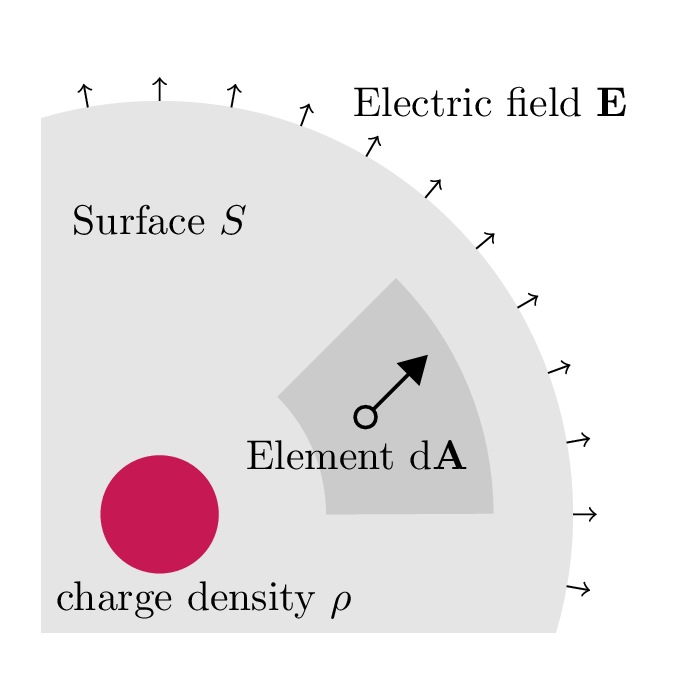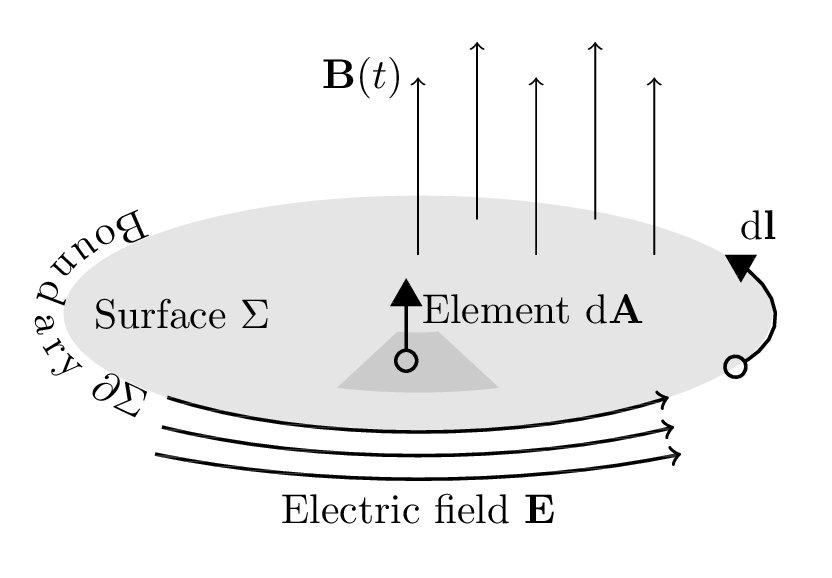Scope
- 25-minute trial lecture
- Aimed at the audience for Electrodynamics course
- Assumed knowledge:
- Integral form of Maxwell's equations
- Vector calculus theorems
Image: CC-BY-SA 2.0 Зеленый кабинет
Aims
- Motivate, derive differential form of Maxwell's equations
- Discuss implications of Maxwell's
equations, including:
- No monopoles
- Wave equation
- To place Maxwell's equations in a broader context
(e.g. as an example of unification of forces)
Recap: Gauss's law - integral form
"The total electric flux flowing through a closed surface is proportional to the electric charge inside"
$$ {\large\unicode{x222F}}_S \mathbf{E} \cdot \mathrm{d}\mathbf{A} = \frac{Q}{\varepsilon_0} \vphantom{\iiint_V}$$
- $\unicode{x222F}_S$: integral over a closed surface (called $S$)
- $\mathbf{E}$: electric field
- $\mathrm{d}\mathbf{A}$: infinitesimal element of surface $S$
- $\varepsilon_0$: permittivity of free space
- $Q$: total electric charge inside $S$
$$\require{color} {\large\unicode{x222F}}_S \mathbf{E} \cdot \mathrm{d}\mathbf{A} = {\color{red}\frac{1}{\varepsilon_0}\iiint_V \rho \, \mathrm{d}V} $$
- $\unicode{x222F}_S$: integral over a closed surface (called $S$)
- $\mathbf{E}$: electric field
- $\mathrm{d}\mathbf{A}$: infinitesimal element of surface $S$
- $\varepsilon_0$: permittivity of free space
- $\rho$: charge density
- $\iiint_V$: integral over volume $V$ enclosed by $S$
Gauss's law
$$ \underbrace{{\large\unicode{x222F}}_S \mathbf{E} \cdot \mathrm{d}\mathbf{A}}_\text{Total electric flux through surface $S$} = \frac{1}{\varepsilon_0} \underbrace{\iiint_V \rho \, \mathrm{d}V}_\text{Charge in volume $V$ bounded by surface $S$} $$

Divergence theorem
"The flux of a vector field through a surface depends on how the vector field behaves inside the surface"
$$ \iiint_V (\nabla \cdot \mathbf{F}) \, \mathrm{d}V = {\large \unicode{x222F}}_S \mathbf{F} \cdot \mathrm{d}\mathbf{A} $$
- True for any $V$ and $S$
- $\mathbf{F}$ must be smooth
Other sources: Khan Academy, Feynman lectures
Applying the divergence theorem
- We have: $$ \iiint_V (\nabla \cdot \mathbf{F}) \, \mathrm{d}V = {\large \unicode{x222F}}_S \mathbf{F} \cdot \mathrm{d}\mathbf{A} $$
- And we want to apply it to Gauss's law for electric fields: $${\large\unicode{x222F}}_S \mathbf{E} \cdot \mathrm{d}\mathbf{A} = \frac{1}{\varepsilon_0}\iiint_V \rho \, \mathrm{d}V $$
- We can immediately use it to rewrite the left hand side: $$\iiint_V (\nabla \cdot \mathbf{E}) \, \mathrm{d}V = \frac{1}{\varepsilon_0}\iiint_V \rho $$
- As it is true for any $V$, we can just write: $$ \fbox{$\nabla \cdot \mathbf{E} = \frac{\rho}{\varepsilon_0}$}.$$
Gauss's law - differential form
"Electric field lines start and end on electric charges"
$$ \nabla \cdot \mathbf{E} = \frac{\rho}{\epsilon_0} $$
Images: CC-BY-SA 3.0 Nicoguaro [1], [2] after Gonfer.
Other sources: Hyperphysics, Wikipedia, Bleaney & Bleaney, Feynman lectures.
Gauss's law for magnetic fields
"The total magnetic flux flowing through a closed surface is always zero"
$$ {\large\unicode{x222F}}_S \mathbf{B} \cdot \mathrm{d}\mathbf{A} = 0$$
- $\unicode{x222F}_S$: integral over a closed surface (called $S$)
- $\mathbf{B}$: magnetic field
- $\mathrm{d}\mathbf{A}$: infinitesimal element of surface $S$
Applying the divergence theorem again
- We have: $$ \iiint_V (\nabla \cdot \mathbf{F}) \, \mathrm{d}V = {\large \unicode{x222F}}_S \mathbf{F} \cdot \mathrm{d}\mathbf{A} $$
- And we want to apply it to Gauss's law for magnetic fields: $${\large\unicode{x222F}}_S \mathbf{B} \cdot \mathrm{d}\mathbf{A} = 0 $$
- Again, use it to rewrite the left hand side: $$\iiint_V (\nabla \cdot \mathbf{B}) \, \mathrm{d}V = 0 $$
- As it is true for any $V$, we can drop the integral: $$ \nabla \cdot \mathbf{B} = 0. $$
Gauss's law for magnetic fields
"Magnetic field lines never end"
$$ \nabla \cdot \mathbf{B} = 0 $$
- No magnetic monopoles!
- All magnets are (at their simplest) dipoles
Other sources: Hyperphysics, Wikipedia, Bleaney & Bleaney, Feynman lectures.
Recap: Faraday's law of induction
"A time-varying magnetic flux induces an electric field"
$$ {\large\unicode{x222E}}_{\partial \Sigma} \mathbf{E} \cdot \mathrm{d} \mathbf{l} = - \frac{\partial \Phi_B}{\partial t} \vphantom{\frac{\mathrm{d}}{\mathrm{d}t} \iint_\Sigma} $$
- $\unicode{x222E}_{\partial \Sigma}$: integral over a closed loop ($\partial \Sigma$, boundary of surface $\Sigma$)
- $\mathbf{E}$: electric field
- $\mathrm{d}\mathbf{l}$: infinitesimal line element along loop $\partial \Sigma$
- $\Phi_B$: total magnetic flux through $\Sigma$
$$\require{color}{\large\unicode{x222E}}_{\partial \Sigma} \mathbf{E} \cdot \mathrm{d} \mathbf{l} = - {\color{red} \frac{\mathrm{d}}{\mathrm{d}t} \iint_\Sigma \mathbf{B} \cdot \mathrm{d} \mathbf{A}} $$
- $\unicode{x222E}_{\partial \Sigma}$: integral over a closed loop ($\partial \Sigma$, boundary of surface $\Sigma$)
- $\mathbf{E}$: electric field
- $\mathrm{d}\mathbf{l}$: infinitesimal line element along loop $\partial \Sigma$
- $\iint_\Sigma$: integral over surface $\Sigma$ bordered by $\partial \Sigma$
- $\mathbf{B}$: magnetic field
- $d\mathbf{A}$: infinitesimal element of surface $\Sigma$
Faraday's law of induction
$$ \underbrace{{\large\unicode{x222E}}_{\partial \Sigma} \mathbf{E} \cdot \mathrm{d} \mathbf{l}}_\text{Voltage around closed loop $\partial \Sigma$} = \underbrace{ - \frac{\mathrm{d}}{\mathrm{d} t} \iint_\Sigma \mathbf{B} \cdot \mathrm{d} \mathbf{A}}_\text{Rate of change of magnetic flux through surface $\Sigma$} $$

Stokes' Theorem
"The flux of the curl of a vector field through a surface is equal to the integral of the vector field along the boundary of the surface"
$$ \iint_\Sigma (\nabla \times \mathbf{F}) \cdot \mathrm{d}\mathbf{A} = {\large\unicode{x222E}}_{\partial \Sigma} \mathbf{F} \cdot \mathrm{d}\mathbf{l} $$
- True for any $\Sigma$ bounded by $\partial \Sigma$.
- Surface $\Sigma$ is not (in general) closed
Applying Stokes' Theorem
- We have: $$ \iint_\Sigma (\nabla \times \mathbf{F}) \cdot \mathrm{d}\mathbf{A} = {\large\unicode{x222E}}_{\partial \Sigma} \mathbf{F} \cdot \mathrm{d}\mathbf{l} $$
- And we want to apply it to Faraday's law: $$ {\large\unicode{x222E}}_{\partial \Sigma} \mathbf{E} \cdot \mathrm{d} \mathbf{l} = - \frac{\mathrm{d}}{\mathrm{d} t} \iint_\Sigma \mathbf{B} \cdot \mathrm{d} \mathbf{A} $$
- Use it to rewrite the left hand side: $$ \iint_\Sigma (\nabla \times \mathbf{E}) \cdot \mathrm{d}\mathbf{A} = - \frac{\mathrm{d}}{\mathrm{d} t} \iint_\Sigma \mathbf{B} \cdot \mathrm{d} \mathbf{A}$$
- Take the surfaces $\Sigma$ to be the same: $$ \fbox{$\nabla \times \mathbf{E} = -\frac{\partial \mathbf{B}}{\partial t}$} $$
Faraday's law of induction
"A time-varying magnetic field induces an electric field"
$$ \nabla \times \mathbf{E} = -\frac{\partial \mathbf{B}}{\partial t} $$
Direction of the magnetic field? Lenz'z law.
"Nature works to oppose a change in flux"
Other sources: Hyperphysics, Wikipedia, Bleaney & Bleaney, Feynman lectures.
Lenz's law - video
Video: CC-BY-SA 4.0 Andrejdam.
Recap: Ampère's law
(actually due to Maxwell!)
$$ {\large\unicode{x222E}}_{\partial \Sigma} \mathbf{B} \cdot \mathrm{d} \mathbf{l} = \mu_0 \iint_\Sigma \mathbf{J} \cdot \mathrm{d}\mathbf{A} $$
- $\unicode{x222E}_{\partial \Sigma}$: integral over a closed loop ($\partial \Sigma$, boundary of surface $\Sigma$)
- $\mathbf{B}$: magnetic field
- $\mathrm{d}\mathbf{l}$: infinitesimal line element along loop $\partial \Sigma$
- $\mu_0$: permeability of free space
- $\iint_\Sigma$: integral over surface $\Sigma$
- $\mathbf{J}$: electric current density
- $\mathrm{d}\mathbf{A}$: infinitesimal surface element of $\Sigma$
Applying Stokes' Theorem
- We have: $$ \iint_\Sigma (\nabla \times \mathbf{F}) \cdot \mathrm{d}\mathbf{A} = {\large\unicode{x222E}}_{\partial \Sigma} \mathbf{F} \cdot \mathrm{d}\mathbf{l} $$
- And we want to apply it to Ampère's law: $$ {\large\unicode{x222E}}_{\partial \Sigma} \mathbf{B} \cdot \mathrm{d} \mathbf{l} = \mu_0 \iint_\Sigma \mathbf{J} \cdot \mathrm{d}\mathbf{A} $$
- Use it to rewrite the left hand side: $$ \iint_\Sigma (\nabla \times \mathbf{B}) \cdot \mathrm{d}\mathbf{A} =\mu_0 \iint_\Sigma \mathbf{J} \cdot \mathrm{d}\mathbf{A} $$
- Take the surfaces $\Sigma$ to be the same: $$ \fbox{$\nabla \times \mathbf{B} = \mu_0\mathbf{J}$} $$
Ampère's law - video
Video: CC-BY-SA 4.0 Andrejdam.
Something is missing
- For any vector field $\mathbf{F}$, the following is true: $$ \nabla \cdot (\nabla \times \mathbf{F}) = 0$$
- This works for Faraday's law: $$ \nabla \cdot (\nabla \times \mathbf{E}) = \nabla\cdot\left( - \frac{\partial \mathbf{B}}{\partial t} \right) = - \frac{\partial}{\partial t} (\nabla \cdot \mathbf{B}) = 0. $$
- But for Ampère's law: $$ \nabla \cdot (\nabla \times \mathbf{B}) = \mu_0 (\nabla\cdot\mathbf{J}). $$ 🤔 $\nabla \cdot \mathbf{J} \neq 0$ in general (capacitors?)
- In fact, there is the continuity equation $$ \nabla \cdot \mathbf{J} = -\frac{\partial \rho}{\partial t} $$ and we must take this into account.
The displacement current
- Starting with the continuity equation $$ \nabla \cdot \mathbf{J} = -\frac{\partial \rho}{\partial t} $$
- Now apply Gauss's law $$ \nabla \cdot \mathbf{J} = -\frac{\partial \rho}{\partial t} = -\frac{\partial}{\partial t}(\varepsilon_0 \nabla \cdot \mathbf{E}) = -\nabla \cdot \left( \varepsilon_0 \frac{\partial \mathbf{E}}{\partial t} \right) $$
- The bit $ \epsilon_0 \frac{\partial \mathbf{E}}{\partial t}$ will fix the problem with Ampère's law
- Maxwell called this the displacement current...
...but it is not a real current
Ampère's law
"A time-varying electric flux induces a magnetic field"
With the displacement current piece added: $$ \fbox{$ \nabla \times \mathbf{B} = \mu_0 \mathbf{J} + \mu_0 \varepsilon_0 \frac{\partial \mathbf{E}}{\partial t} $} $$
(quick check...) $$ \nabla \cdot (\nabla \times\mathbf{B}) = \mu_0 \big(\underbrace{\nabla \cdot \mathbf{J} + \frac{\partial}{\partial t} \underbrace{\varepsilon_0 \nabla \cdot \mathbf{E}}_{= \rho}}_{ = 0} \big) $$
Other sources: Hyperphysics, Wikipedia, Bleaney & Bleaney, Feynman lectures.
Summary: Maxwell's equations
$$ \begin{align} \nabla \cdot \mathbf{E} & = \frac{\rho}{\varepsilon_0} & \text{Gauss's law}\\ \nabla \cdot \mathbf{B} & = 0 \vphantom{\rho_m} \\ \nabla \times \mathbf{E} & = - \frac{\partial \mathbf{B}}{\partial t} & \text{Faraday's law} \\ \nabla \times \mathbf{B} & = \mu_0 \mathbf{J} + \mu_0 \varepsilon_0 \frac{\partial \mathbf{E}}{\partial t} & \text{Ampère's law} \end{align} $$
Other sources: Hyperphysics, Wikipedia, Bleaney & Bleaney, Feynman lectures.
Maxwell's equations in context
- Unification of forces
- Electricity and magnetism are facets of a single theory
- Later, we incorporated weak nuclear interactions into an expanded theory - electroweak theory
- Light as travelling electromagnetic waves
- Maxwell came up with the "displacement current" in 1861 as a purely theoretical construct
- It had the consequence of predicting that travelling electromagnetic waves existed
- The existence of electromagnetic travelling waves was then shown by Hertz in 1888
Other sources: Hyperphysics on unification, EM waves; Feynman lectures on EM waves and unification.
No free monopoles

Picture: Corinne Mucha [source and further reading]
No free monopoles
$$ \nabla \cdot \mathbf{B} = 0 $$- In 1931 Dirac showed that if at least one magnetic monopole existed somewhere, electric charge would be quantised
- Searches for magnetic monopoles have been going on for decades but we have never seen one
- The MoEDAL experiment at the LHC is looking for evidence of magnetic monopoles
How do Maxwell's equations change?
$$ \begin{align} \nabla \cdot \mathbf{E} & = \frac{\rho}{\varepsilon_0} \\ \nabla \cdot \mathbf{B} & = 0 \vphantom{\rho_m} \\ \nabla \times \mathbf{E} & = - \frac{\partial \mathbf{B}}{\partial t} \\ \nabla \times \mathbf{B} & = \mu_0 \mathbf{J} + \mu_0 \varepsilon_0 \frac{\partial \mathbf{E}}{\partial t} \end{align} $$
$$ \require{color} \begin{align} \nabla \cdot \mathbf{E} & = \frac{\rho_{\color{red}e}}{\varepsilon_0} \\ \nabla \cdot \mathbf{B} & = {\color{red}\rho_m} \\ \nabla \times \mathbf{E} & = - \frac{\partial \mathbf{B}}{\partial t} {\color{red} - \mathbf{J}_m}\\ \nabla \times \mathbf{B} & = \mu_0 \mathbf{J}_{\color{red} e} + \mu_0 \varepsilon_0 \frac{\partial \mathbf{E}}{\partial t} \end{align} $$
More symmetrical!
Maxwell's equations - summary
- Describe time evolution of $\mathbf{E}$ and $\mathbf{B}$ fields
- Their differential form implies conservation of charge - through the "displacement current"
- Led to the prediction of electromagnetic waves
- Unification of electricity and magnetism
- Further developments led to special relativity
Next time
- Travelling electromagnetic waves
(check out quick review question!) - Maxwell's equations in media
- Boundary conditions
- Snell's law